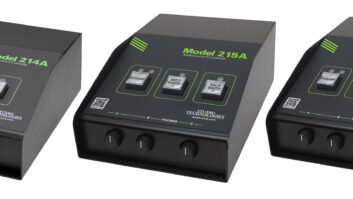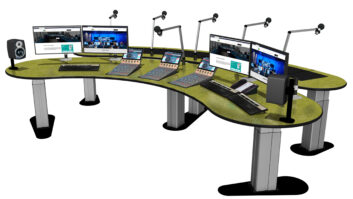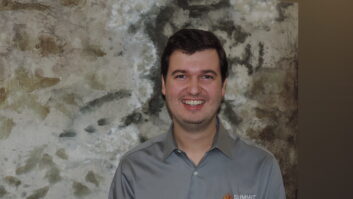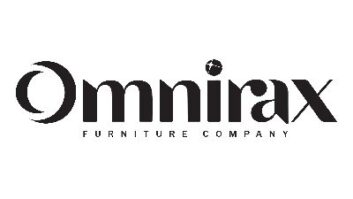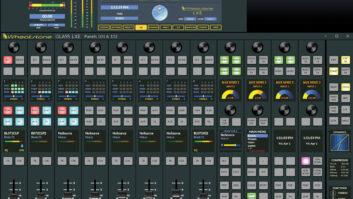Digital and IP technology have changed the face of the radio broadcasting industry over the last decades. One area that might at first glance seem impervious to the march of digital would be studio design and furniture. Yet it, too, has succumbed to the seemingly all-consuming digital catalyst.
Radio World asked several industry project planners about this.

A Studio Technology project at Binnie Media. Note the single equipment rack set off to the side and computer equipment far more centrally located.The Evolving Studio Countertop
Vince Fiola, Studio Technology — I speak to quite a few engineers regarding their preferences for furniture in their studios. While some prefer to just stick with the way things have been done for years, others see the changes in technology as a way to make positive changes to their studio furniture as well.
The most apparent change that I have noticed is the reduction of both above-counter and below-counter rack space. If there is even a need for an equipment rack above the counter, the placement has changed from easily accessible, to somewhere out of the way. Rack space below the countertop can be reduced due to the decrease in the amount of equipment and wiring needed. A well-vented accessible cabinet to store computer hardware alongside a rack area is becoming more common.
In the creative studio end of things, we are being asked to maintain more counter work surface in the “traditional console” location by moving the mixing console into a secondary position off to the right or left. This enables the levels to be set on the board and allows a comfortable area in the traditional operator position to work on digital editing for longer periods of time.
We are also beginning to get more requests for adjustable-height work surfaces. This allows for each operator’s preference while they work, but it can still put a dent in the budget.
Finally, with the reintroduction of vinyl records as a viable media in some parts of our industry, we are being asked to make room for turntables once again in some air studios. When I started working in broadcast in the early 1980s, turntables were the norm — proving once again that everything old becomes new again.

Westwood One’s Culver City, Calif., studio shows a changing face of radio studios. More open, less formal, there’s even a couch. The area can also be cleared to create a live performance space.Digital Routing Is the Core
Conrad Trautmann, Chief Technology Officer, Westwood One — Our studio and facility concerns vary depending on whether it’s new/refurb or acquisition. In all cases, the first consideration is, “What is the house router system?” Clearly, we’d like to be compatible with what we’re using to route audio. In some locations, we have SAS 32KD systems, and in others we’re using Telos Axia. If we’re putting in a new studio in an existing facility with one of these systems already in place, it makes sense to extend the routing system to the studio. In the case of a new build, it’s highly likely we’d install an IP audio-based system.
Looking at a hot topic, accommodating video, we do consider and plan for it when we are gutting and building a new control room/studio. Not so much for edit workstations or smaller production rooms.
Another topic of interest is green and more energy-efficient technologies. We’ve made use of newer LED technology, which provides good coverage and much less heat than older incandescent lighting did. That also helps with air conditioning loads and operating costs as well.
We have been building performance spaces at some of our specialized facilities such as our famous TM Studios in Dallas. Studio A there is a sight to behold. It was built as a professional recording studio, and it gets used every day for our original music products and jingle business. In our Culver City facility, we have a studio that has moveable furniture to allow a band to set up if needed.

From the audience’s perspective, this studio looks like a TV set. This Omnirax design has recessed monitors and switches, and low profile mic booms to accentuate the “new face of radio.” Plus, it’s bolted together and on hidden casters, so it can be moved out of the way to create a performance space for in-studio bands.
Credit:
Photo by Claire TallericoCalling for Visual Radio
David Holland, Omnirax Furniture Co. — We’re seeing a lot of call for visual radio. At the 2014 NAB Show, at least 50 percent of the people we talked to that were planning new studio builds were considering some type of video component in their project. Simulcast, streaming video, webcasting — all need to overcome the visual clutter of radio’s typical above-counter profusion of monitors and mic booms and present a clean face to the cameras.
The trend presents itself as a desire to recess monitors, lower mic booms, pay more attention to sight lines, add glam features such as lighting and shiny tops. It’s a subject that comes up in any larger build-out — both preparing for it in the near term and anticipating it coming down the road.
Beyond that there is a less-is-more trend, as in less rack space generally. But, as we well know, people are not getting any smaller — so sound ergonomics and attention to the individual needs of each person in the room is an immediate and enduring trend.

Inside the Airstream trailer studio. The control room is at one end, while the recording room/performance space is at the other.
Credit:
Photo by Cheryl Fleming.Expanding the Studio Envelope
John Storyk, Walters-Storyk Design Group — Walters-Storyk Design Group has built studios in a basement (Electric Lady) and a penthouse (Jungle City), but a recent project was the first time we’ve worked in an Airstream trailer. Dave Pentecost, director of technology for New York’s Lower Eastside Girls Club, brought WSDG a compelling challenge: “Can you create a pro recording/broadcast/teaching studio within the confines of a 140-square-foot Airstream trailer?”
With a live booth for broadcast and recording and a control room to mix programming for LEGC’s WGRL Internet radio station, this compact studio also creates sound tracks for student videos and their planetarium’s educational presentations. The control room accommodates three students and an instructor. The front booth can host four guests. Visible from the street, the Airstream resides in the second floor, stage-equipped, classroom/ community room.
The compact 5.1 surround-ready CR features an Avid C/24 mixing console, Genelec speakers, Manley, API, Rupert Neve Designs, Universal Audio, SSL (and other) processing gear, along with Neumann, Royer, Shure and Sennheiser mics to provide club members with a professional, hands-on recording experience.
Radio projects remain an important aspect of the WSDG client mix. We are currently involved in two public broadcast station projects. KEXP(FM) in Seattle is preparing to move to a brand-new facility in the Seattle Center. It will feature cutting-edge broadcast and recording studios, and, a live performance venue. We are also in planning stages with KPFK Public Radio in Hollywood. This award-winning station is upgrading its original home with an acoustical update of their live performance studio and a new control room.

Clean lines and modern finishes are proving popular, as typified by Arrakis’ Accent line.Wallets Are Cracking Open
Ben Palmer, Arrakis Systems — About six years ago, in the middle of the recession, we mostly got standard finish/standard design orders — whatever was cheapest. Now that the economy is doing a little better, we have been receiving a lot of requests for custom colors for the side panels and tabletops, as well as custom designs for the configurations. We have also been moving away from the older finishes, and have adopted a modern look with our Accent line. We have found that high-end studios prefer this look to the older finishes.





